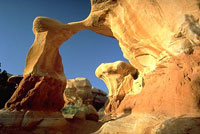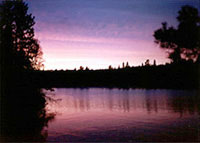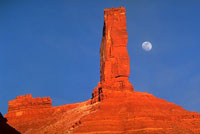It was a beautiful night spent sitting by a waterfall in the southern Utah wilderness that convinced Sen. Russ Feingold (D-Wis.) of the need for more discussion in the Senate about wilderness and public lands issues. “I’ve had the good fortune to sea kayak the Apostle Islands, to canoe the Boundary Waters, and to hike in Utah wilderness,” says Feingold in a phone interview between votes on the Senate floor. “My interest was always there,” he explains. But these trips inspired a passion, and the Utah trek ultimately galvanized him into action.

Southern Utah sandstone.
Photo by John George, courtesy of SUWA.
So, on Sept. 8, Feingold announced the formation of a Senate Wilderness and Public Lands Caucus as part of this year’s 35th anniversary celebration of the Wilderness Act of 1964. The bipartisan caucus will provide “a forum where members of the Senate can discuss public lands and wilderness issues in an exchange across party lines,” says Feingold.
“There’s never been anything like this before,” says Tom Price of the Southern Utah Wilderness Alliance, who helped arrange Feingold’s trip to Utah this spring.
Wild at Heart
“There is an element of swimming upstream,” Feingold says of the current political climate for wilderness protection. “But because it is a difficult time for wilderness, that’s precisely why it’s the right time” for such a caucus.

Sunset over the Boundary Waters.
Legislative action to protect public lands and wilderness has been minimal in the last few years, leading Feingold to believe that members of the Senate need to be educated on “certain principles that are not well understood.” These, he says, are the principles behind the Wilderness Act, advanced by “wilderness thinkers and leaders” such as Aldo Leopold, John Muir, and Gaylord Nelson, whose Senate seat Feingold now holds.
There are “lots of new members in the House and Senate who were not around when a lot of wilderness bills were passed,” points out Rindy O’Brien, vice president of policy for the Wilderness Society, who sees this caucus as a way for senators to learn more about wilderness issues. Sen. Dianne Feinstein (D-Calif.), one of the original caucus members, describes the forum as an “educational” rather than a strategic tool.
Still, Feingold says one of the caucus’s roles will be to assist members of the Senate in defending existing wilderness areas, and to provide support and advice to members seeking to designate new areas. “The focus of the group,” says Kristian Denny in the office of caucus member Sen. Patty Murray (D-Wash.), “is to team up to push conservation legislation and get it onto the floor.”
Other members of the caucus are Sens. Evan Bayh (D-Ind.), Barbara Boxer (D-Calif.), Richard Durbin (D-Ill.), Peter Fitzgerald (R-Ill.), Bob Graham (D-Fla.), and John McCain (R-Ariz.), cosponsor of Feingold’s campaign finance reform bill. A “Dear Colleague” letter has gone out from Feingold’s office inviting other senators to join in the fun.

A senator preparing to rock the boat?
Keeping the West Wild
There are now about 20 wilderness bills in some form of development, involving areas from Alabama to the Arctic, and grassroots groups around the country are working to build support for the measures and other wilderness efforts. The majority of places now under consideration for wilderness designation are in the West, where there is some of the strongest legislative opposition to additional wilderness, coming from lawmakers seeking to protect natural-resource-dependent industries.
“Politicians are lagging behind the public in the move for wilderness protection,” says Bill Meadows, president of the Wilderness Society, with whom Feingold has been canoeing in Minnesota’s Boundary Waters Canoe Area Wilderness.
Recent polling conducted by a coalition of conservation groups, including the Wilderness Society and Heritage Forests Campaign, indicated that 88 percent of the public is in favor of more wilderness and open space protection. “To be on the wrong side of protecting wilderness,” says Feingold, “is not smart public policy.”
Why the disconnect between Congress and the American people on the issue of wilderness protection? “The conservation community isn’t political enough, and hasn’t built enough coalitions,” says Oregon conservation activist Andy Kerr.

Wilderness on the rocks?
Photo by Tom Till, courtesy of SUWA.
Ken Rait, campaign director of the Heritage Forest Campaign, sees a pressing need to educate both the public and politicians on wilderness issues. The polls, he explains, show that the public generally thinks all public land is wilderness, and that National Forests receive the same protection as National Parks.
But Rait cautions, “Wilderness is contentious and is going to remain a contentious issue as industry is in its dying throes in terms of public land extraction.” Meadows agrees that there’s plenty of work ahead: “Wilderness efforts take a long time. It’s not just legislation you pass overnight.”
The first meeting of the Senate Wilderness and Public Lands Caucus has yet to be scheduled. Perhaps all members should be issued hiking boots and topo maps, and told the group will meet, not around a table in the Hart Senate Office Building, but somewhere in the Owyhee Canyonlands in the intermountain West, or in the Black Hills of South Dakota, or atop Steens Mountain in Oregon.

